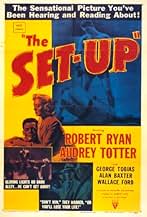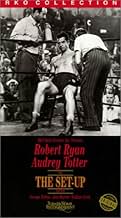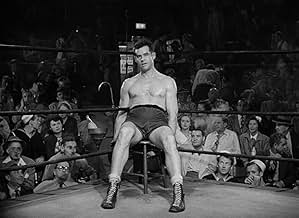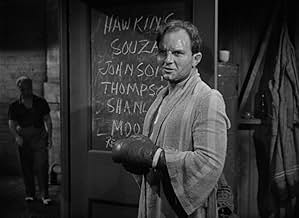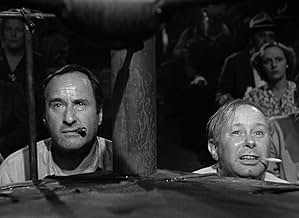IMDb RATING
7.8/10
11K
YOUR RATING
Expecting the usual loss, a boxing manager takes bribes from a betting gangster without telling his fighter.Expecting the usual loss, a boxing manager takes bribes from a betting gangster without telling his fighter.Expecting the usual loss, a boxing manager takes bribes from a betting gangster without telling his fighter.
- Nominated for 1 BAFTA Award
- 2 wins & 2 nominations total
Hal Baylor
- Tiger Nelson
- (as Hal Fieberling)
Kevin O'Morrison
- Moore
- (as Kenny O'Morrison)
Herbert Anderson
- Husband
- (uncredited)
Larry Anzalone
- Mexican Fighter
- (uncredited)
Arthur Berkeley
- Cafe Patron
- (uncredited)
Phil Bloom
- Minor Role
- (uncredited)
Burman Bodel
- Man
- (uncredited)
- Director
- Writers
- All cast & crew
- Production, box office & more at IMDbPro
Featured reviews
Fight scenes-wise, this was "Rocky" almost 30 years before there ever was a "Rocky." It was the same kind of unrelenting (and unrealistic in that no matter how bad the beating the good guy was getting, the good guy couldn't lose) boxing action that Sylvester Stallone likes so much.
But, don't get me wrong, I liked this film. It was good stuff. 'Rocky" was drama, romance while this was film-noir.....and solid film-noir, too.
Robert Ryan, playing a 35-year-old aging rank fighter, gives it his all against an up-and-coming kid, not knowing that he supposed to take a dive. He finally finds this out (his manager didn't tell him) and by then, he was not going give up trying against his opponent.
There are so many punches thrown in this four-round bout it will make your head swim. The best part of this film, to me, was the cinematography, which was outstanding. Kudos to director Robert Wise for the photography. There are a lot of nice facial closeups in here, all of which look sharp on the recent DVD transfer.
Humor is thrown into this film-noir as we see a variety of boxing fans, from the bloodthirsty woman to a fat man always eating to another guy acting out the action while in his ringside seat. They provide some much- needed respite from the grim story. Ryan, as he usually was, is interesting to watch. The ending of the film is a tough one and, I found tough to watch at times.
Note: the film was done in "real time" - a 72-minute period in the life of the boxer Ryan portrays.
But, don't get me wrong, I liked this film. It was good stuff. 'Rocky" was drama, romance while this was film-noir.....and solid film-noir, too.
Robert Ryan, playing a 35-year-old aging rank fighter, gives it his all against an up-and-coming kid, not knowing that he supposed to take a dive. He finally finds this out (his manager didn't tell him) and by then, he was not going give up trying against his opponent.
There are so many punches thrown in this four-round bout it will make your head swim. The best part of this film, to me, was the cinematography, which was outstanding. Kudos to director Robert Wise for the photography. There are a lot of nice facial closeups in here, all of which look sharp on the recent DVD transfer.
Humor is thrown into this film-noir as we see a variety of boxing fans, from the bloodthirsty woman to a fat man always eating to another guy acting out the action while in his ringside seat. They provide some much- needed respite from the grim story. Ryan, as he usually was, is interesting to watch. The ending of the film is a tough one and, I found tough to watch at times.
Note: the film was done in "real time" - a 72-minute period in the life of the boxer Ryan portrays.
Robert Ryan is a victim of "The Set-Up" in this 1949 film also starring Audrey Totter, George Tobias and Percy Helton. Ryan plays Stoker Thompson, a 35-year-old prize fighter who is still trying to make it. Totter is his wife, who wants him to quit before he's crippled and/or brain-damaged. In fact, she's not even sure she can watch him fight anymore, though he begs her to come to the arena. What he doesn't know is that his handlers have accepted money for him to take a fall. They don't bother telling him because they believe he's going to lose anyway.
Hollywood has long had a love affair with the fight business. It's easy to see why - it's a visual sport and one-on-one, and there's always a story to tell, either about a loser or an egomaniacal winner. "The Set-Up" is a fascinating film brilliantly directed by Robert Wise, with the boxing match done in real time. The action switches back and forth from the arena to Stoker's wife walking through the dark city trying to sort out her feelings and ultimately ripping up her ticket to the match. Meanwhile, Stoker keeps looking out the window at his apartment window - when he sees that the lights are off, he believes she's coming to the fight.
The fight itself is incredibly realistic and brutal, and the focus is on what can only be described as sadists sitting around the ring yelling, truly man at his most barbaric in Wise's approach. The entire experience - the fight and the audience reactions - is very uncomfortable. The match is difficult enough to watch, but the aftermath is worse for the tension factor alone. Interestingly, Wise lets us see the violence in the ring and let's us imagine some of the violence outside of it later.
For a time in his career, Robert Ryan had kind of a gentle giant thing going occasionally. A very prolific actor, he could be pathetic, as he is here, or take on a character with mental or emotional problems with ease. As his career continued, he played increasingly more angry and violent men. Toward the end of his career, however, he portrayed John the Baptist and Nolan in "The Man Without a Country." He's terrific here as a sad, desperate man going for the glory when he's just about washed up; he is in a business with no humanity, yet he sticks out because he is kind and reeks of goodness. Audrey Totter is very good as his wife, who loves him and wants more for him than being beaten up. Tobias and Helton give great performances as men whose souls left them a long time ago. The rest of the cast is equally good.
This film makes a profound impression on the viewer, and if you're not interested in fighting, you definitely won't be after this film. If you're a fan of the sport, you'll perhaps ask yourself why. No matter what, you won't be unaffected.
Hollywood has long had a love affair with the fight business. It's easy to see why - it's a visual sport and one-on-one, and there's always a story to tell, either about a loser or an egomaniacal winner. "The Set-Up" is a fascinating film brilliantly directed by Robert Wise, with the boxing match done in real time. The action switches back and forth from the arena to Stoker's wife walking through the dark city trying to sort out her feelings and ultimately ripping up her ticket to the match. Meanwhile, Stoker keeps looking out the window at his apartment window - when he sees that the lights are off, he believes she's coming to the fight.
The fight itself is incredibly realistic and brutal, and the focus is on what can only be described as sadists sitting around the ring yelling, truly man at his most barbaric in Wise's approach. The entire experience - the fight and the audience reactions - is very uncomfortable. The match is difficult enough to watch, but the aftermath is worse for the tension factor alone. Interestingly, Wise lets us see the violence in the ring and let's us imagine some of the violence outside of it later.
For a time in his career, Robert Ryan had kind of a gentle giant thing going occasionally. A very prolific actor, he could be pathetic, as he is here, or take on a character with mental or emotional problems with ease. As his career continued, he played increasingly more angry and violent men. Toward the end of his career, however, he portrayed John the Baptist and Nolan in "The Man Without a Country." He's terrific here as a sad, desperate man going for the glory when he's just about washed up; he is in a business with no humanity, yet he sticks out because he is kind and reeks of goodness. Audrey Totter is very good as his wife, who loves him and wants more for him than being beaten up. Tobias and Helton give great performances as men whose souls left them a long time ago. The rest of the cast is equally good.
This film makes a profound impression on the viewer, and if you're not interested in fighting, you definitely won't be after this film. If you're a fan of the sport, you'll perhaps ask yourself why. No matter what, you won't be unaffected.
The Set-Up is directed by Robert Wise and stars Robert Ryan & Audrey Totter. The screenplay was adapted by Art Cohn from a 1928 poem written by Joseph Moncure March. The story (played out in real time) sees Ryan as Stoker Thompson, a 35 year old nearly washed up boxer still trundling around the circuit believing he's still got what it takes to become a champ. In spite of pleas from his fretful wife, Julie (Totter), Stoker gets in the ring with Tiger Nelson (Hal Baylor), a man 12 years younger. Unbeknownst to Stoker, though, his manager Tiny (George Tobias) has struck a deal with underworld gangster Little Boy (Alan Baxter on prime sweaty and icy form) for him to take a dive and let Nelson win.
What first struck me the most watching this was just how vile everyone apart from the boxers are. The fighters are actually the only ones with honesty and integrity running through their veins. These guys are the ones with the self respect being a chief issue for them, they are fighting not just for glory, but for a basic human trait. The first half of the film puts us in the boxers changing room as the fighters wait to go out into the ring. Here we see the number of noble pugilists stripped back to reveal either their fears or their blind beliefs - while they in turn wait to see who comes back victorious or defeated. As they chat amongst themselves the atmosphere is palpable and Wise excellently uses cutaways to the excitable and blood thirsty crowd. The impact is to that of a gladiatorial arena and shows the sport to be seedy yet utterly beguiling at the same time.
Then it's on to Stoker's fight where Ryan is terrific (he actually boxed for College for 4 years). Thompson is a character so stand up, yet driven by foolish pride, it puts Stallone's Rocky Balboa firmly in the shade, his whole "just one punch away" mantra is truly wonderful and heartfelt and leads to one of those endings that are frustratingly brilliant in its bittersweet closure. The whole fight with Nelson has a beautiful fluidity about it (former pro boxer John Indrisano choreographed it), with Milton R. Krasner's photography keeping it grim and humanistic - both in the ring and out on the darkly lit L.A. streets as Totter's conflicted wife ponders a potential battering for her stoic husband.
Boosted up by a towering performance from Ryan, and dripping with a film noir sense of desolation, The Set-Up is a simple but powerful boxing gem. A film that gets down to the nitty-gritty of the fighters and the seedy people that surround them. 9/10
What first struck me the most watching this was just how vile everyone apart from the boxers are. The fighters are actually the only ones with honesty and integrity running through their veins. These guys are the ones with the self respect being a chief issue for them, they are fighting not just for glory, but for a basic human trait. The first half of the film puts us in the boxers changing room as the fighters wait to go out into the ring. Here we see the number of noble pugilists stripped back to reveal either their fears or their blind beliefs - while they in turn wait to see who comes back victorious or defeated. As they chat amongst themselves the atmosphere is palpable and Wise excellently uses cutaways to the excitable and blood thirsty crowd. The impact is to that of a gladiatorial arena and shows the sport to be seedy yet utterly beguiling at the same time.
Then it's on to Stoker's fight where Ryan is terrific (he actually boxed for College for 4 years). Thompson is a character so stand up, yet driven by foolish pride, it puts Stallone's Rocky Balboa firmly in the shade, his whole "just one punch away" mantra is truly wonderful and heartfelt and leads to one of those endings that are frustratingly brilliant in its bittersweet closure. The whole fight with Nelson has a beautiful fluidity about it (former pro boxer John Indrisano choreographed it), with Milton R. Krasner's photography keeping it grim and humanistic - both in the ring and out on the darkly lit L.A. streets as Totter's conflicted wife ponders a potential battering for her stoic husband.
Boosted up by a towering performance from Ryan, and dripping with a film noir sense of desolation, The Set-Up is a simple but powerful boxing gem. A film that gets down to the nitty-gritty of the fighters and the seedy people that surround them. 9/10
I love Robert Ryan films. Whether playing a scum bag or a hero, his gritty and realistic performances have always impressed me. One of his better films is this boxing flick. Ryan is an old washed-up boxer who is expected to take a dive. Through much of the film, you really don't know what he will do--throw the fight or try to salvage some of his dignity. And, I gotta say that the boxing scenes are brutal and realistic--it really HURTS to watch the fight. If you like the films THE HARDER THEY FALL or REQUIEM TO A HEAVYWEIGHT, then is this movie for you! In fact, try watching all three to get a look at the less glamorous and seedy side of boxing.
If your taste runs to happy endings and beautiful people than stay away from The Set-Up. But if gritty and realistic drama is your taste you can't do better than this noir classic about the world of boxing. The Set-Up anticipated Rod Serling's Requiem For a Heavyweight by a decade as it deals with the same issues about a boxer at the end of his career.
Anthony Quinn might very well have seen Robert Ryan in The Set-Up when he played Mountain Rivera in Requiem For A Heavyweight. Rod Serling must have seen it as well. Both films deal with a boxer at the end of his career, but who has a lot of pride. Manager George Tobias and trainer Percy Helton get an offer from gambler Alan Baxter who is backing an up and coming heavyweight contender Hal Baylor. Ryan is just another step up the ladder, a ladder when Ryan was younger he was climbing. Tobias and Helton agree to take a dive, but no one can broach the subject to Ryan.
Which sets it all up for the final match and the aftermath where Ryan betrayed by all hangs in on nerve and pride alone. What happens afterward is for you to view, but don't expect the same kind of resolution that Requiem For A Heavyweight gave.
A really big surprise here are George Tobias and Percy Helton who normally play comic parts are quite serious here as a pair of fight game characters. The performances are so atypical of the work you've come to expect from both.
Ryan's amateur boxing career no doubt stood him in good stead for this role. He makes a rugged looking boxer who's been through the ring wars over and over again. That helps him in this latest encounter.
The sets are gritty and realistic, in fact I've never seen an urban area done so well until Otto Preminger's The Man With The Golden Arm debuted six years later. Preminger also might have been influenced by The Set-Up when he made his classic.
Although unnoticed at first, The Set-Up has slowly built a reputation as one of the great noir films out of RKO and one of the best boxing films ever made. For myself it certainly influenced a lot of people.
Anthony Quinn might very well have seen Robert Ryan in The Set-Up when he played Mountain Rivera in Requiem For A Heavyweight. Rod Serling must have seen it as well. Both films deal with a boxer at the end of his career, but who has a lot of pride. Manager George Tobias and trainer Percy Helton get an offer from gambler Alan Baxter who is backing an up and coming heavyweight contender Hal Baylor. Ryan is just another step up the ladder, a ladder when Ryan was younger he was climbing. Tobias and Helton agree to take a dive, but no one can broach the subject to Ryan.
Which sets it all up for the final match and the aftermath where Ryan betrayed by all hangs in on nerve and pride alone. What happens afterward is for you to view, but don't expect the same kind of resolution that Requiem For A Heavyweight gave.
A really big surprise here are George Tobias and Percy Helton who normally play comic parts are quite serious here as a pair of fight game characters. The performances are so atypical of the work you've come to expect from both.
Ryan's amateur boxing career no doubt stood him in good stead for this role. He makes a rugged looking boxer who's been through the ring wars over and over again. That helps him in this latest encounter.
The sets are gritty and realistic, in fact I've never seen an urban area done so well until Otto Preminger's The Man With The Golden Arm debuted six years later. Preminger also might have been influenced by The Set-Up when he made his classic.
Although unnoticed at first, The Set-Up has slowly built a reputation as one of the great noir films out of RKO and one of the best boxing films ever made. For myself it certainly influenced a lot of people.
Did you know
- TriviaThe clock on the square at the beginning shows 9:05 PM, and the same clock at the end shows 10:16 PM. The movie takes place in real time.
- GoofsAfter the big fight, when Stoker is in the locker room, he opens his locker and takes out his clothes and shoes. In two subsequent shots his shoes are back in the locker, and then in a fourth shot he removes his shoes from the locker a second time.
- ConnectionsFeatured in Film Review: Robert Wise (1967)
- How long is The Set-Up?Powered by Alexa
Details
- Release date
- Country of origin
- Language
- Also known as
- El luchador
- Filming locations
- The Hill Street Tunnels at 1st, Bunker Hill, Downtown, Los Angeles, California, USA(Staircase over tunnel scenes, the overlook where Julie contemplates suicide as train passes. Location was the Hill Street Tunnels, including the pedestrian staircase leading to overlook. Location was just north on Hill Street from 1st Street. Erected in 1913 and demolished in 1954 to make way for Los Angeles County Courthouse and Hall of Administration.)
- Production company
- See more company credits at IMDbPro
- Runtime
- 1h 13m(73 min)
- Color
- Aspect ratio
- 1.37 : 1
Contribute to this page
Suggest an edit or add missing content

